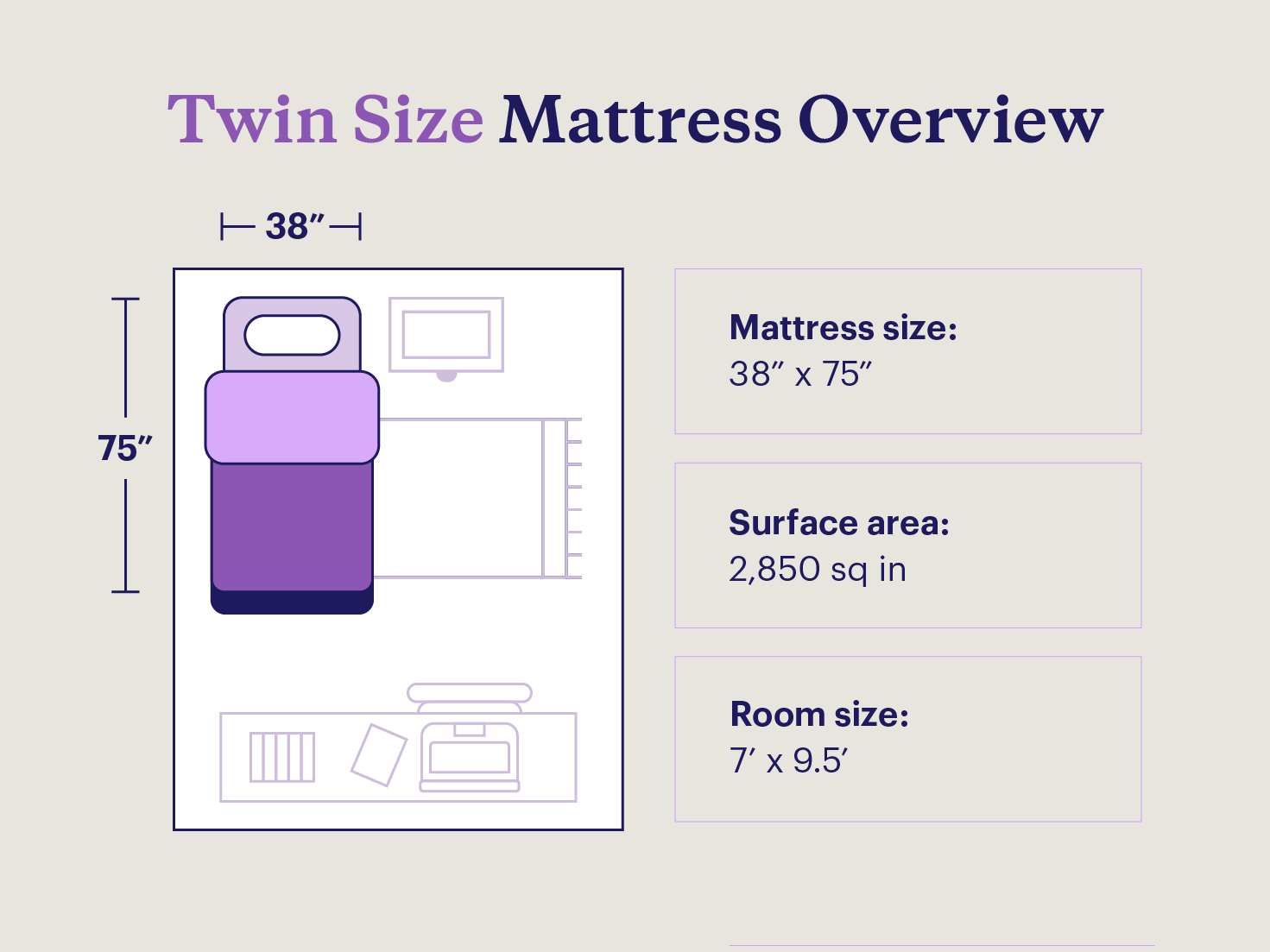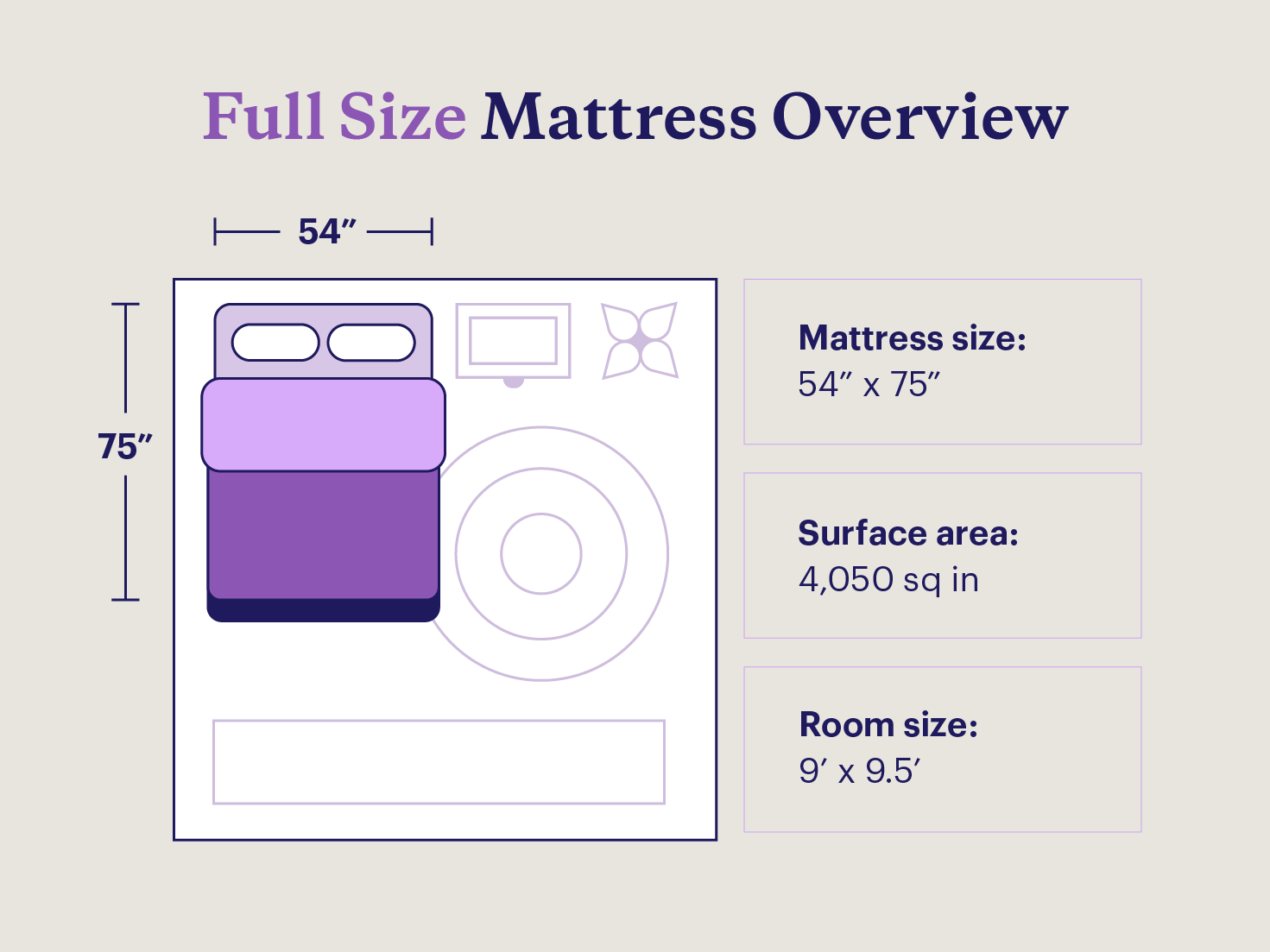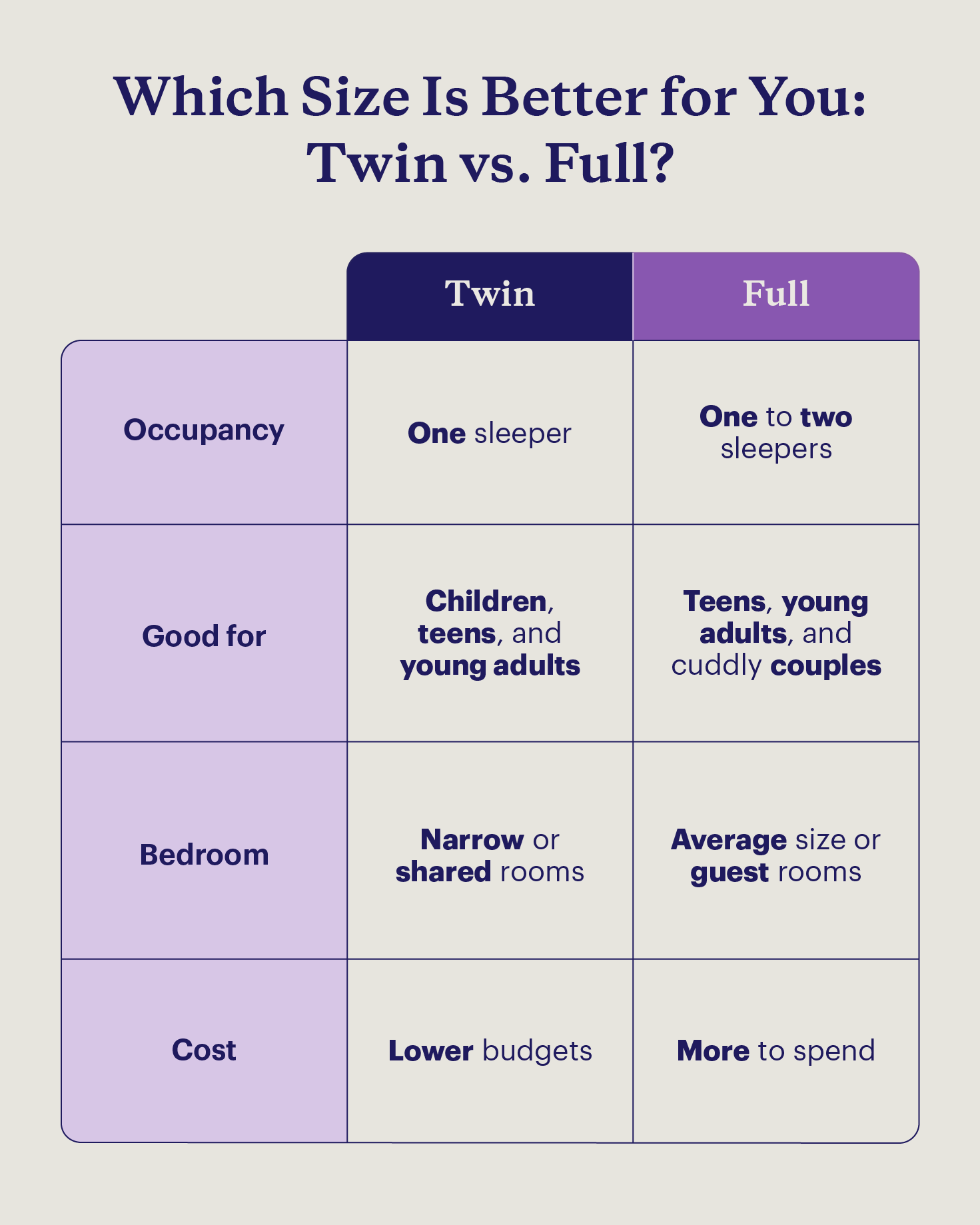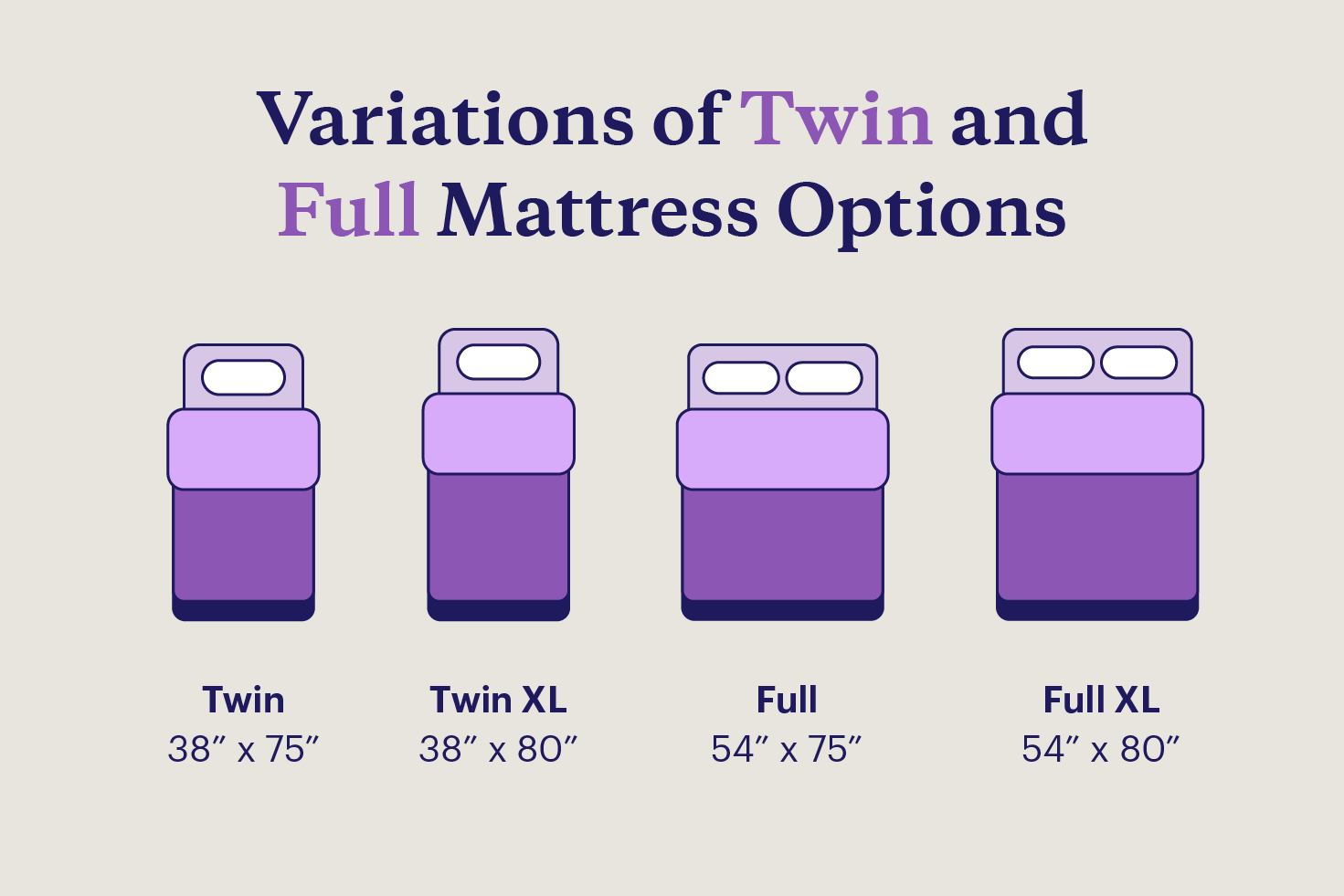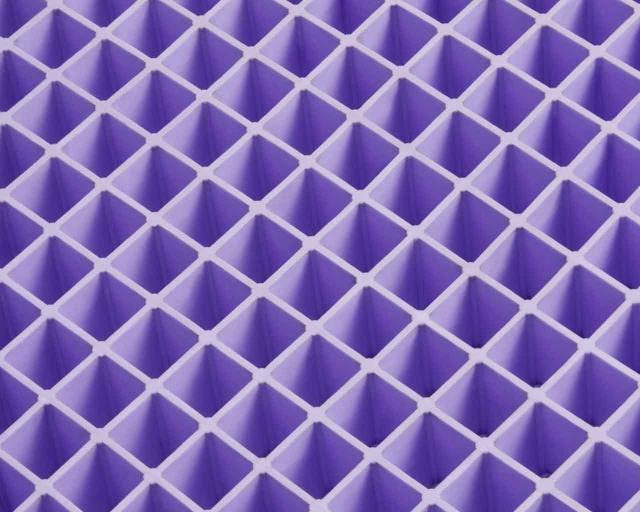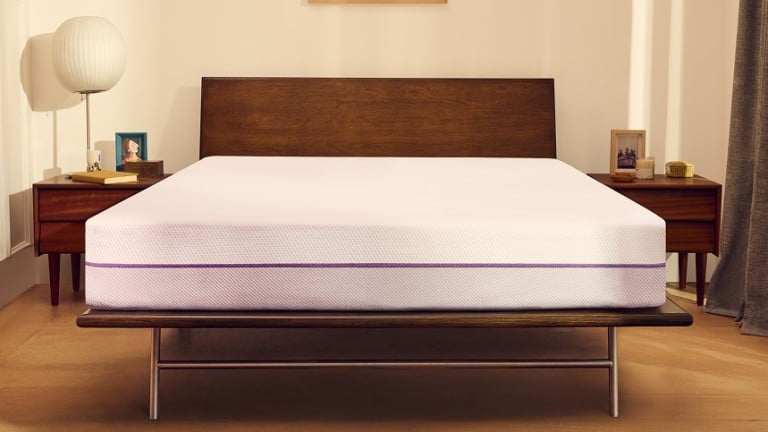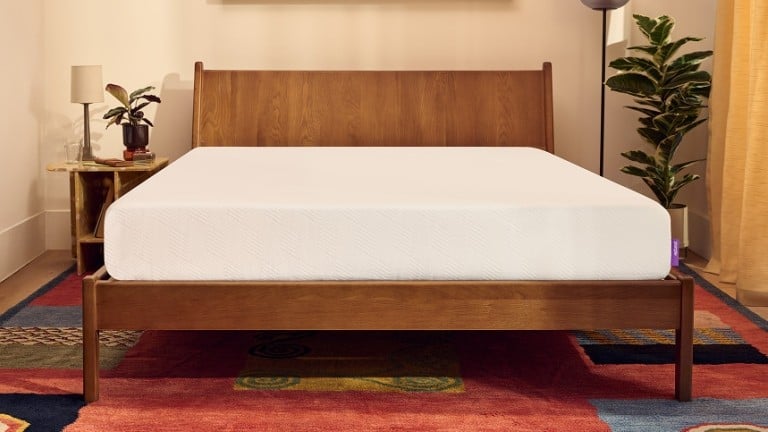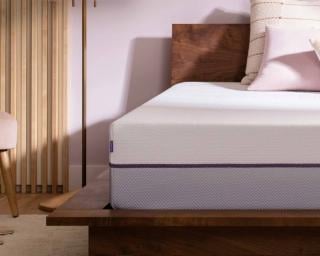Twin vs. Full: Key Differences + Mattress Size Comparison
Key Takeaways:
- A twin mattress is 38 inches wide and a full mattress is 54 inches wide, making a full 16 inches wider than a twin.
- Although twins are narrower than full beds, twin and full mattresses both measure 75 inches in length.
A twin mattress is best for one sleeper while a full can fit up to two if necessary, although most couples prefer a larger bed long term.
If you’re torn between buying a twin or full size bed, there are a number of considerations you should take into account before making the investment.
The main difference between a twin vs. full mattress is the width. A twin and full mattress are both 75 inches long, although a full mattress is 54 inches wide whereas a twin is 38 inches wide.
We’ve put together this guide to help you decide which mattress size suits your needs best. Read on to learn everything you need to know about twin vs. full mattresses.
Twin vs Full Mattress Comparison Chart
The comparison chart below highlights the main differences between a twin and full mattress at a glance.
Twin | Full | |
Width | 38 inches | 54 inches |
Length | 75 inches | 75 inches |
Surface Area | 2,850 square inches | 4,050 square inches |
Minimum Room Size | 7’ x 9.5’ | 9’ x 9.5’ |
Number of Sleepers | 1 | 1-2 |
Best for | Children, teenagers, and young adults | Teens, young adults, cuddly couples, and guest rooms |
Price | $ | $-$$ |
What Is A Twin Bed?
Dimensions: 38-by-75 inches
Standard twin mattresses measure 38 inches wide by 75 inches long, offering a surface area of 2,850 square inches. Otherwise referred to as single beds, twins are the smallest mattress size aside from crib mattresses. The conservative size of a twin mattress makes it an ideal option for bunk beds as well as smaller or shared bedrooms.
Pros | Cons |
Good for small or shared spaces | Only fits one sleeper |
Perfect for children and teens | Little room to stretch out |
Affordable | Not suitable for sleepers over 6 feet tall |
Pairs well with most bunk beds | Not suitable for larger bodies |
Benefits of a Twin Mattress
Here are the biggest benefits of owning a twin size mattress.
- Good for small or narrow spaces: A twin mattress is great if you have limited space. The standard twin bed is a great fit for most regular size bedrooms or dorm rooms because of its compact size, allowing room for other furniture.
- Affordable: Twin mattresses might be your top choice if you’re a single sleeper on a budget. Compared to larger mattress sizes like a king or queen, twin mattresses are generally less expensive.
- Kid-friendly: Twin mattresses are great for helping young children transition to a larger mattress when they’ve grown out of their toddler beds. Twin mattresses are also the standard mattress size for bunk beds, although some lower bunk beds are built to take up a full mattress.
Drawbacks of a Twin Mattress
Some of the drawbacks of choosing a twin size mattress include:
- Fits only one: Twin beds can comfortably fit just one person. Unless you’re getting a single mattress for a child or planning to purchase multiple ones, a twin bed may be less than adequate.
- Too short for some: Twins are the smallest mattress size for sale. While a twin bed can fit most average size adults, taller sleepers might find it too short for a good night’s rest.
- Too narrow for some: At 38 inches across, a twin may not offer enough width for individuals with larger bodies as there is little room to stretch out. Additionally, most mattresses have weight limits and as the smallest mattress size, a twin may not be able to support heavier weights.
What Is a Full Mattress?
Dimensions: 54-by-75 inches
A full size mattress measures 54 inches wide and 75 inches long, with a surface area of 4,050 square inches. Although the same length, a full is 16 inches wider and offers 1,200 more square inches of sleeping space than a twin size mattress.
Otherwise known as a double bed, a full mattress is a perfect beginner mattress for older teenagers and young adults living alone for the first time.
While the 54-inch width of a full mattress may be able to fit two people, you may find it somewhat uncomfortable, especially if you’re not accustomed to those sleeping conditions. In contrast, a full bed will feel a lot roomier for a single adult, particularly if you’re transitioning from sleeping on a twin mattress. It’s also one of the most popular mattress sizes in the U.S.1
Pros | Cons |
Wide enough for a single sleeper to sprawl out | Not ideal for most couples long term |
Plenty of bedding options on the market | May not be long enough for sleepers over 6 feet tall |
Can fit two sleepers if necessary | Takes up more floor space than a twin |
More affordable than a queen or full bed | Usually more expensive than a twin |
Benefits of a Full Mattress
Here are a few pros of owning a full size mattress.
- Less mattress, more room: If your bedroom allows for a mattress larger than a twin, you might want to opt for a full. This provides you with a more surface area to sleep on without taking up too much floor space or restricting movement. Additionally, a bigger bed than a full size might make it difficult to access your closet, furniture, or other personal effects if your room is smaller than 81 square feet.
- Great for single sleepers: Twin beds don't give an adult much room to comfortably sprawl out. In contrast, a full size mattress offers a generous amount of sleeping space for one person, allowing you to toss, turn, and spread out.
- Relatively affordable: A full mattress is typically more affordable than a queen and king mattress, as full beds are made with less material while still providing ample space.
- Compatible with queen headboards and frames: If you are into vintage or antique furniture, a full mattress provides an avenue for exciting decor options. Because full beds were the most popular size until 1950, you could get a Victorian, shaker, or art deco bed frame to go with your mattress. Plus, many adjustable bases for mattresses or headboards built for a queen bed are compatible with full beds.
Drawbacks of a Full Mattress
Below are some of the cons to keep in mind when considering a full size mattress.
- Not long enough: If you’re over 6 feet tall, you might find your head hitting against your headboard or your feet struggling to find legroom with a full bed. In such instances, king or queen size beds could be the best option.
- Not enough space for couples: Though some couples are comfortable on full size mattresses, some prefer more sleeping space to avoid elbowing and kneeing their partners when they change positions in the middle of the night. Similarly, couples who like having their kids or pets in bed with them might enjoy the 60 or 76 inches of width that a queen or king bed provides.
- Requires a larger bedroom: The larger surface area of a full compared to a twin means a full mattress will require a larger bedroom. Although a full may fit in smaller rooms, you’ll lose floor space and walking room if opting for a full vs. a twin.
- Higher cost: Compared to a twin of the same make and model, a full size mattress will always cost more as it is made from more materials. If you have a tight budget and are looking for a bed for just one sleeper, you may want to consider a twin instead.
Key Differences Between Twin vs. Full Mattresses
Twin and full mattresses have a few important features that distinguish one from the other. Here are the major differences between a twin and full bed to consider when choosing a mattress:
Dimensions
The most noticeable difference between a twin and full mattress is their dimensions. Measuring 54 inches across, a full size mattress is 16 inches broader than a twin. That said, both mattresses offer 75 inches in length.
Room Size
In most cases, it’s best to choose a mattress that’s no wider than half the width of your bedroom. This allows you to fill your space with any other furniture like a dresser or nightstands.
As a general rule, these are the minimum recommended room sizes for the two bed sizes:
- Twin: 7-by-9.5 feet
- Full: 9-by-9.5 feet
A twin mattress may fit better in a smaller room because of its narrow width, but the full isn’t much wider and can also fit in smaller rooms. This makes full mattresses the perfect size for studio apartments and guest bedrooms.
Measure your room to determine what size bed you should get first. Be sure to consider if your bedroom has any protruding closets or alcoves.
Uses
In most scenarios, both twin and full mattresses fit single sleepers best. A twin works well for children transitioning from a crib or toddler bed, but its dimensions can also fit an adult.
While some might argue a full size bed is generous for just one sleeper, it can accommodate more than one person when needed. For instance, a full mattress is roomy enough for two children to sleep quite comfortably. The best bed size for couples varies, so some couples may prefer a full size bed, especially if they have a smaller primary bedroom and like spending the night close to each other.
Comfort
Are you 6 feet tall or shorter? Either a twin or full mattress will be sufficiently comfortable. If you’re tall, then you might prefer a full size mattress — it’s wider than a twin and would be more comfortable for a single sleeper, given the extra space.
But if you’re any taller than 6 feet, you may want to explore bigger mattress sizes, as twin and full mattresses have the same length of 75 inches. A mattress with sufficient surface area and sleeping space will help reduce the risk of physical discomfort and health challenges.2
Price
How much a mattress costs is determined by several things, such as the brand, mattress type, size, material, and quality. Twin size beds are generally less expensive, even though upgrading to a full mattress is not a big difference price-wise. This may be partly because of the demand for these mattresses and their lifespan.
Purple mattresses start at:
- Twin: $699
- Full: $1,199
Accessories
As twin and full mattresses are both widely available, accessories in these sizes are as well. You’ll have no trouble finding twin or full flat and fitted sheet sets, duvets, pillows, and more.
If you’re on a lean budget, the relative affordability of a twin size mattress may be a deciding factor. Many of the accessories for twin mattresses, such as sheets, comforter sets, and mattress pads, are also more affordable than their full bed counterparts. Twin beds also only require one pillow whereas a full bed looks fully made with two, even if it’s only for one sleeper.
Should You Get a Twin or Full Bed?
To pick between a twin and full mattress, you need to consider your circumstances and needs. The following scenarios might provide some clarity for you to make the best choice.
When To Choose a Twin Mattress
You may want to consider a smaller bed like the twin size if you’re:
- Upgrading your child from a crib to their first “grown-up” mattress
- Assembling a bunk bed
- Wanting the least expensive option for a mattress
When To Choose a Full Mattress
You may want to consider a larger bed like the full size if you’re:
- A recent college graduate moving into a new apartment
- Living alone as a single person with a lower budget
- Looking for a bed that your child can grow into
- Shopping for a versatile mattress to put in a guest room
Twin vs. Full Mattress Size Variations
Both twin and full mattresses are made in extra long sizes to suit taller sleepers. These mattresses are known as the twin XL and full XL.
Twin XL
Dimensions: 38-by-80 inches
A twin XL mattress measures 38 inches wide and 80 inches long. The difference between a standard twin and a twin XL is 5 inches in length, making twin XLs great options for taller sleepers. Compared to a full, a twin XL is 16 inches narrower and 5 inches longer. The twin XL’s surface area is 1,010 square inches smaller than the full.
Like the standard variation, twin XLs suit single sleepers best, as their width doesn’t allow for much extra room. Twin XLs are most common in college dorm rooms but also work for shared teen rooms, bunk rooms in vacation rentals, or young adults with small bedrooms. This mattress size is widely available, so accessories are easy to find.
Full XL
Dimensions: 54-by-80 inches
A full XL mattress measures 54 inches in width and 80 inches in length. Compared to the standard full size, a full XL has the same width but is 5 inches longer — the same length as twin XL, queen, and king mattresses. This difference in length equates to 270 square inches more surface area in the full XL.
If needed, the full XL can fit two sleepers up to 6 feet 4 inches tall. Unlike twin XLs, the full XL is not as widely available, so finding accessories like sheets and bed frames may be a challenge or require a custom order.
Sleep Better With the Right Size Mattress From Purple
There are many reasons you might be considering a twin or full mattress. Whether you’re buying a new bed for your guest room or transitioning your toddler to a larger mattress, choosing between a twin vs. full size mattress is as simple as taking your budget, bedroom size, and comfort into account.
Whichever size fits your needs best, look to Purple for mattresses in all standard sizes. Our innovative GelFlex® Grid cradles your body exactly where you need support, keeping you comfortable and cool all night long.
FAQ
The main difference between a full and twin mattress is in the width. Both twin and full mattresses are 75 inches long. But at 54 inches wide and 75 inches long, a standard full is bigger than a twin by 16 inches in width.
The bed size that is bigger than a twin but smaller than a full is a twin XL mattress. You might find the twin XL to be a happy medium between the two. Twin XL mattresses have the same width as twin beds (38 inches) but offer an extra 5 inches in length, which taller individuals might prefer.
If you’re looking for just one mattress for two kids, a full bed is fine for children 10 years old or younger. Depending on their height, older kids can use a full XL mattress (54-by-80 inches), which offers 5 inches of additional length than a standard size full mattress.
Yes, an adult can sleep on a twin bed. With a length of 75 inches, twin beds can accommodate sleepers up to 6 feet tall.
Though a full bed technically has enough room to accommodate two adults, it is more comfortable enough for one.
No, two twin beds do not make a full. The width of two twin beds together equals a king mattress’s width (76 inches) but isn’t quite long enough. If you want to make a king bed, you should use two twin XL mattresses insteads to reach the right length (80 inches).
No, a twin bed is great for sleepers of all ages but it’s not the most comfortable choice for more than a single occupant. Meanwhile, a full mattress is suitable for one to two sleepers.
More To Explore
Level up your sleep routine with our most-loved products.

